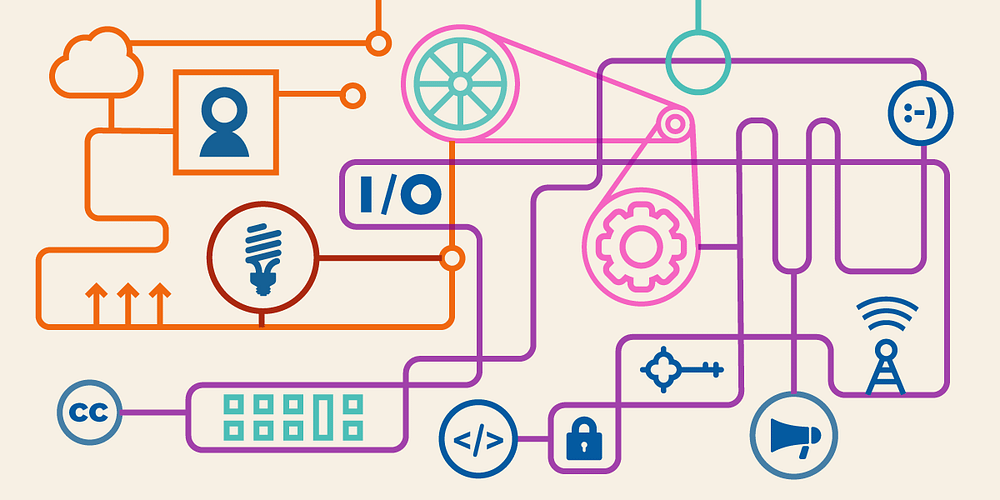The Top three problems that need to be solved to open the gates for mass adoption.
A group of blind men heard that a strange animal, called an elephant, had been brought to the town, but none of them were aware of its shape and form. Out of curiosity, they said: “We must inspect and know it by touch, of which we are capable”.
So, they sought it out, and when they found it they groped about it. The first person, whose hand landed on the trunk, said, “This being is like a thick snake”. For another one whose hand reached its ear, it seemed like a kind of fan.
As for another person, whose hand was upon its leg, said, the elephant is a pillar like a tree-trunk. The blind man who placed his hand upon its side said the elephant, “is a wall”. Another who felt its tail, described it as a rope. The last felt its tusk, stating the elephant is that which is hard, smooth and like a spear.
This is a story taken from an early Buddhist text: Tittha Sutta, Udāna 6.4, Khuddaka Nikaya dated around 500 BCE.
Much like these blind men, many of us engaged in the crypto space have the same affliction. Unfortunately, we have been so focused on creating solutions within the crypto space that we failed to take note of the broader implications, only to get pounded into the ground this past year with the constant hacks and bankruptcies.

We have lost sight of the bigger picture.
It can be very easy to get carried away in your work and social circles and not notice that you’ve begun to fall astray from the path.
What do I mean by this?
Crypto, in general, is developing at a rapid pace, with Dapps and Nft launches flying through Crypto Twitter left right and centre. But in reality, many of these projects follow the same path. The low-hanging fruit of DeFI has all but been picked, and every Dex is just a copy of one another. And how many more 10,000 mint AI-generated art Collections do we really need?
My point is innovations seem to be slowing slightly and especially innovation to the problems that are actually required are all but tapering to a drip.
It’s required once in a while to step back and relook at the space from the first principles.
- What was Crypto designed for -> Decentralised, Secure, Scalable ledgers
What’s the point in creating a really fast scalable Layer 1 like Solana? For example, when you trade decentralisation for speed, you have basically created another Web 2.0 App similar to AWS or Google Cloud.
2. What do we need to solve for mass adoption, i.e. how do we now get people to use the tech that has been built on mass?
There’s no point in making another DeFi project when it’s not going to be able to affect the people it’s designed to because they’re not onboarded into Crypto.
In the article, I’m going to lay out the most significant challenges and problems that need to be solved in order for all the tech currently built to start getting some actual use.

Problem 1 — Decentralised Identification (DIds)
One of, if not the most complicated problems yet to be fully solved and implemented is that of Identification. How do you tie a person to a wallet?
You may be asking what the need for Identities is; wasn’t blockchain set up so that you don’t need to verify yourself or create an account, at the end of the day, it’s permissionless.
And yes, I totally agree; if it were up to me, there would be no Ids, not KYC, as introducing any of these aspects opens the door to censorship and allows for more overarch by governments.
However, it’s important to look at the bigger picture. For Crypto to begin getting adoption traction, we need big institutions like banks and insurance companies to come on board. In the regular Financial world, Identity is a foundation on which a business is built. You just have to know who you are doing business with, if not for your own security, then to comply with the regulation.
Any business holding client funds need to perform KYC and AML checks by law in most countries. And banks looking to give out loans need to perform a credit check at the very least.
Yes, we do have DeFI lending, but at the moment, every protocol needs the use of collateral(usually much greater than the loan value) to secure that loan. If the whole world ran off this principle, growth would most probably be non-existent.
As annoying as it seems, we need the old Financial world or at least aspects of it. To achieve wider adoption and facilitate growth in the DeFi space, a balance between traditional financial practices and the benefits of decentralisation must be found, aptly named RealFI. And that requires on-chain Identification.
So what are the proposed solutions?
Centralised Identification — The simplest solution is to take what already works and just use it in Crypto. Have a centralised authority like a government or Large Corp and have them verify Identification using real-world documents and link it to an address, possibly using a non-transferable NFT.
While this solution works and is pretty easily implemented, it sort of breaks the point of Crypto being decentralised. What if that provider went down? What if the provider began to censor or charge exorbitant rates?
Ideally, we want to find a solution that is decentralised and on-chain.
Biometrics — A Promising solution is the use of biometrics. For example, you could have an NFT minter Contract that takes some biometric data, such as a fingerprint and returns some non-transferable NFT hash to the account if that biometric is unique.
Now we have addresses linked to verified humans, we move to the next step, which would be Identification. For privacy reasons, most people would not want their Id to be openly displayed against their address. However, when interacting with an entity that requires Identification, you can choose to send in your biometric data, which can be checked against the NFT hash on your address. In this way, a User can choose to whom they identify themselves.
The problem of decentralised On chain Identity is a complex problem to solve, and there are many projects attempting to tackle it from many different angles. And while it goes against the freedom and privacy pillars that blockchain was set up on, it’s a necessary evil that we need to accept for the overall benefit and growth of the space.

Problem 2 — Custody
“99% of People’ Will Lose Crypto Storing in Self-Custody”: Binance CEO Changpeng Zhao
Yes, he does have somewhat of a bias in this case, with Binance probably being one of the biggest crypto custodians alongside the world’s biggest exchange. But in this case, I think he is right.
There are two aspects to custody that I think are important to point out. The first is the average knowledge base of the median soon-to-be Crypto Hodler. While it may be easy for the initiated to move around assets and set up wallets, for the general joe, it’s a slide to madness as they see their account getting drained by an email scam the minute they withdraw their funds of binance.
It’s also not reasonable to teach these skills to everybody. I tend to hear the response, “we will teach them”, “they will learn”, or “we need more education” from others in the space, but that is simply unfeasible. It’s 2023, and we have barely managed to move the majority to online banking, let alone teach them about public-private encryption protocols.
We need to build dumb, idiot-proof UI/UX interfaces and systems for the masses, not because they are dumb or lack mental cognition, but simply because the average person just does not have the time or interest to learn about this topic. The future system of money and computation should just work; out of the box, no installation required, with zero complexity and friendly, intuitive UI.
Security
I recently bought a ledger nano s, transferring nearly all my Cardano from my browser’s hot wallet to Cold storage, and it was actually relatively easy. However, the one thing that struck me was my seed phrase for all my wealth is now on a simple bit of Card with the Ledger logo bang at the top of it. If anyone but me comes across this, my Crypto is gone.
With crypto storage, we have basically gone back in time to where you kept your gold coins under the floorboards of your house, with the gold being your SeedPhrase or Private key, written on paper, engraved in metal or any other numerous methods of storing text. Not to mention, due to the removal of the weight variable, your wealth becomes much more stealable.
Just imagine a future where everybody self custody their life’s savings in Crypto stores their keys on their own property. How many more break-ins would we see each year when the potential theft value is not capped at that 4k Tv screen but the 2mil of bitcoin hiding note wedged in an old book?
I would imagine quite a lot.
But here is where Im torn. If self-custody isn’t a viable option and third-party custody is in shambles with FTX, BlockFI etc.. losing the public trust for the foreseeable future, where does one turn?
And this really is why I have listed this as one of the biggest problems. The solution for custody of the global populations crypto is probably going to look something like a hybrid between a regulated, possibly decentralised, 2fa, multi-sig solution. It will need to be so easy a child could use it, have the security guarantees of a bank with a type of FDIC and also have some aspect of decentralisation where a government or corporation cant lock or confiscate your funds.

Problem 3 — Interoperability
Let’s talk about interoperability, quite a big problem that every chain is facing; not only is it a technical problem but one of ego.
Take WiFi, for example; currently, every device can connect to any WiFi network given knowledge of the password. How annoying would it be if iPhones could only use apple routers or Kindle only download books from amazon WiFi areas?
I think we can all agree that interoperability is key to the success of blockchain and also one of the reasons I am so passionate about Cardano, where this is imbedded at its core.
Interoperability ties in directly with UX. If we are to onboard the masses, the UX needs to be seamless. We can’t be having people create 20 different wallets for each layer one and use exchanges as a Crytpo highway. Let alone the knowledge needed to be able to operate on these different chains safely.
I see the main problem behind this being that most layer 1 believes that they are, ironically, ‘the one’ and eventually will beat out every other chain. This is just not going to be the case, and while I think we will see a few major Layer 1’s take the market share in the coming 5–10 years and establish themselves as the new web3.0 base layers, there will be many niche solutions that will all need to work with each other.
Every technology building on blockchain now needs to take interoperability as a serious and mission-critical component and throw aside their ego to build bridges, not roadblocks, for the sake of the whole space.
End Note
This is by no means the limitation of the problems surrounding Crypto, be it privacy, UX or regulation; the tech and solutions that need to be built are endless.
However, from the standpoint of mass adoption, I believe that these three issues are the largest hurdles currently standing in their way. The projects that find viable solutions will see some of the biggest growth and rewards in the coming years.
If you are looking to build a project in the space, I would advise you to think about these issues for Ideas rather than creating another Dex or NFT Project.
Innovate, don’t replicate.









